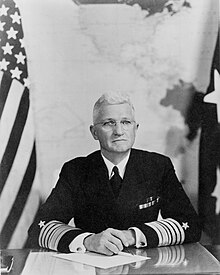Plan Dog Memorandum
The Plan Dog Memorandum was a strategic document of the US Navy , written by Chief of Naval Operations Harold R. Stark in November 1940, in which strategic options of the USA in the event of a two-front war against Japan and the European Axis powers were discussed. The 26-page document, which was described as one of the most important in the formulation of a national American strategy in World War II , described the support of Great Britain or the British Empire as essential for the security of the United States and recommended that in a two-front war in Europe first to take the offensive and remain defensive in the Pacific. It is therefore to be regarded as the first formulation of the later American principle of the Germany First Strategy.
background
During the interwar period, American military planning was based on so-called “ color-coded war plans ”, each of which dealt with the strategy in the event of war with different countries. The most important of these war plans was the so-called War Plan Orange for a war with Japan.
In the course of developments in the international situation towards the end of the 1930s ( Second Sino-Japanese War , heading for a new war in Europe ) , there were increasing signs that the USA could in future be embroiled in a two-front war in Europe and the Pacific. This would have made the previous war plans, which only had a war against one enemy nation as their content, or their extensions in relation to a British-Japanese coalition, obsolete. In the early summer of 1939, directives were issued by the Joint Board of the American Armed Forces (forerunner of the Joint Chiefs of Staff ) to prepare plans for such a multi-front war, which were referred to as Rainbow Plans . Five such plans were drawn up, each based on different premises and recommendations for action.
In the course of further foreign policy developments in 1940 (including the Tripartite Pact ), the question of the priorities of warfare in the event of the USA becoming involved in the conflict arose.
The memorandum
Stark's memorandum, which he submitted to Secretary of the Navy Frank Knox on November 12, 1940, a week after Franklin D. Roosevelt was re-elected for the second time , was based on the premise that a defeat for Great Britain would sooner or later result in an invasion of the Western Hemisphere by the Axis and thus pose an imminent threat to the United States. The national interest demanded the support of Great Britain with all means necessary for its survival. Strongly identified as goals of the USA:
- securing the western hemisphere against invasion by the Axis powers (politically, militarily or economically),
- preventing the collapse of the British Empire,
- the minimization of the Japanese ability to act aggressively by its military with a view to the continued existence of American possessions in the Pacific.
In the further argument, Stark went into the fact that it was unlikely that Great Britain would be able to defeat the Axis powers on its own. He identified four options for action for further US policy:
- A) Defense of the Western Hemisphere while avoiding entry into war against the Axis powers
- B) Prepare a full offensive against Japan (with the support of Great Britain and the Netherlands) and a strict defensive in the Atlantic
- C) Concurrent military support for Great Britain in the Atlantic and Pacific
- D) Preparation of a full offensive against the European Axis Powers with the support of Great Britain and reorientation of the policy towards Japan
From these options, Stark strongly advocated option “D” (hence the name “Plan Dog”). Option “A” should be followed until the US enters the conflict. Stark also spoke out in favor of entering into staff talks with the proposed Allies.
Effects
The memorandum was forwarded to President Roosevelt on November 13, after minor comments from the Army , and received unspoken approval. On December 21, the Joint Board confirmed the recommendations of its planning committees, which largely corresponded to Stark's proposals. In January 1941, the ABC-1 staff talks began with Great Britain, whose government saw Plan Dog as a sustainable basis for cooperation.
After the attack on Pearl Harbor , which brought the United States into the Second World War , Great Britain and the United States decided at the Arcadia Conference to implement the Germany First strategy. Nonetheless, the Americans continued to rely on offensive operations in the Pacific War , albeit to a lesser extent.
The confidentiality status of the document was lifted in 1956.
Web links
- Digitized version of the document on fdrlibrary.marist.edu
Individual evidence
- ^ Louis Morton: Strategy and Command: The First Two Years. United States Army in World War II, The War in the Pacific, 1960, p. 81.
- ↑ Waldo H. Heinrichs: Threshold of War: Franklin D. Roosevelt and American Entry into World War II. Oxford University Press, 1988, ISBN 0-19-506168-3 , p. 38.
- ↑ Notice of Declaration of Confidentiality on the Franklin D. Roosevelt Library pages .
